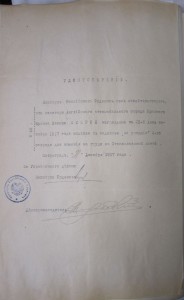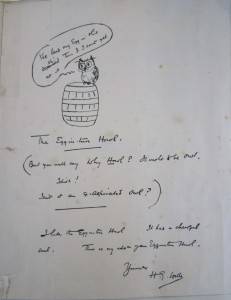Today’s blog is by Louise, archivist at Lothian Health Services Archive (LHSA), as she looks into a very singular wartime life:
On the surface, Yvonne FitzRoy (1891 – 1971) seemed an unlikely nurse. A privileged socialite (daughter of Sir Almeric FitzRoy and Katherine Farquhar), progressive and actress, she was in fact to serve on the battlefields of Russia and Romania as a nursing orderly to Elsie Inglis between 1916 and 1917 with the Scottish Women’s Hospitals (SWH).
The Scottish Women’s Hospitals were set up as soon as war broke out by Edinburgh clinician and suffragist Dr Elsie Inglis, with the financial support of the National Union of Women’s Suffrage Societies (NUWSS).
Dr Elsie Inglis (LHB8A/9)
The all-female SWH units were formed in order to offer medical support to front-line troops, and by the end of the war there had been units based in France, Corsica, Salonika, Serbia, Russia, Romania and Malta. Although rejected by the War Office in Scotland (the famous rebuke to Dr Inglis was that, as a woman, she should ‘go home and sit still’), the aid of the SWH was accepted first by the French Red Cross, and a hospital was set up in Calais to treat Belgian troops. A hospital in the abbey of Royaumant soon followed.
The SWH are perhaps best known through their units in Serbia (work that still links Scotland to the area today). However, the Serbian army’s defeat by Austrian troops forced their withdrawal – Dr Inglis was captured and was returned to Britain; others who could escape chose to retreat in treacherous conditions with the Serbian army. However, in 1916, the London Suffrage Society financed another SWH unit of 80 women to support the Serbian army in Russia and Romania, of which Yvonne FitzRoy was one. LHSA is lucky enough to hold two letter books (LHB8/12/6 and 7) and one scrapbook (LHB8/12/8) that trace Yvonne’s work on this eastern front.
Yvonne’s appointment letter to the SWH (LHB8/12/8)
Luggage label from Yvonne’s journey to serve with the SWH on a captured Austrian ship (LHB8/12/8). According to her memoirs, her luggage consisted of ‘one kit-bag, one haversack, and a rug.’
Although SWH archives are held by Glasgow City Archives and The Women’s Library, the pivotal role played by Elsie Inglis means that we have some intriguing material across LHSA collections (of which more as the weeks go on!): SWH work is reflected in archives from the Bruntsfield Hospital (where Dr Inglis was a surgeon), in the papers of the Elsie Inglis Memorial Maternity Hospital (opened as a memorial to Dr Inglis in 1925 with the remainder of the SWH funds) and in the personal collections of campaigners who fought to keep the memory of Dr Inglis alive. The letters and scrapbook created by Yvonne FitzRoy can be found in LHSA’s Bruntsfield Hospital collection.
Although not solely covering her time at the front, Yvonne’s scrapbook is dominated by the War and its aftermath. Reflecting her artistic and social life as well as her military one, the book is pasted with typed quotations, theatre scripts, postcards and programmes, indicating a love of words, the London stage and the idiosyncratic:
Memorabilia in Yvonne’s scrapbook (LHB8/12/8)
However, the levity of costume design, exhibitions and drama is soon punctuated by newspaper clippings of events in the theatre of war as European tensions grew in 1914.
A typical ‘text heavy’ page in Yvonne’s scrapbook (LHB8/12/8).
As a result of her services to the Russian sick and wounded, Yvonne FitzRoy was awarded a Russian medal for meritorious conduct, the ‘Order of Service’, which she was given government permission to wear:
Certificate of Yvonne FitzRoy’s ‘Order of Service’ medal (LHB8/12/8).
Her service throughout the war was also recognised by the British Red Cross and Order of St John organisations, which worked together during the war after forming a Joint War Committee:
Yvonne’s certificate for wartime services with the British Red Cross Society and the Order of St John of Jerusalem in England (LHB8/12/8).
Like others who served with SWH, Yvonne FitzRoy seemed to have been involved with the Voluntary Aid Detachments, women (who came to be known as VADs) who volunteered in county Red Cross hospitals. Yvonne seems to have used her literary skills in work for a hospital magazine, the Egginton Howl, the magazine of Egginton Hall Red Cross Hospital near Derby.
The Egginton Howl was even praised in this December 1916 article by The Spectator: http://bit.ly/1Ki26lQ. The letter by Rudyard Kipling mentioned in the article is in fact pasted into Yvonne’s scrapbook, indicating that at this time she must have been closely involved in the magazine’s production:
Letter from Rudyard Kipling to Yvonne FitzRoy (LHB12/8/8).
Not content with one literary autograph, Yvonne managed to collect another trophy, in the shape of a questionable pun and endearing sketch from author HG Wells:
HG Wells caricature (LHB8/12/8).
Following the war, Yvonne (like other SWH medical staff) chose to write a memoir of their experiences working on the front line. Her memoir, With the Scottish Nurses in Roumania, was published in 1918, giving an account of her life at the front – it was dedicated to Dr Inglis, who died from cancer on 26th November 1917 just as she had returned to Britain. Yvonne’s adventures did not end with peacetime, however. In 1921, she was appointed as Private Secretary to Alice, Marchioness of Reading, wife of the British Viceroy in India, a post that she occupied until 1926. Yvonne’s life in India can be pieced together through another memoir, Courts and Camps in India: Impressions of Viceregal Tours 1921 – 1924, or through her personal papers from this time held at the British Library. The cuttings and correspondence in her scrapbook also reflect this period of her life:
Greetings card sent from the Viceroy’s Camp, c. 1924 (LHB8/12/8).
Yvonne’s letters home to her parents are more directly focused upon her SWH period, covering September 1916 to January 1917, when she travelled between Russia and Romania with ‘Hospital A’, headed by Dr Inglis. From her journey east to life treating patients at the front and retreating and advancing in the wake of Allied campaigns, Yvonne’s collected letters cover her friendships, leisure time, daily life and the business of staying warm, including frequent mentions of ‘Swedish drill… all of us flat on our backs… waving our grey legs in the air’ (6th September 1916). Frequent references to the ‘Russian censor’ preclude any detailed references to military manoeuvres, victories or defeats, but on some occasions working conditions are mentioned in more detail:
‘Now we are about 10 miles from the firing line, and Hospital B has gone off to act as our clearing station. I am really glad to be in A. B won’t probably see more of the fighting than we shall, and from the medical point of view our work will be the most interesting as they simply dress the wounds and send the men straight on. Here they only stay a day or two if they are well enough but anyway that give us enough time to cope with things a little. Also I am with Dr Inglis and have got the pick of the sisters in my Ward headed by a Bart’s nurse – my word what a difference a big hospital training makes! We arrive just in time for the biggest rush of wounded they’ve yet had and got 100 in before we were half ready. Every soul worked like bricks but the first few days were just terrific. Now, in all the confusion, we are beginning to see daylight and in a day or two shall have our next two Wards open.’ (10th October 1916)
As the extract above hints, Yvonne’s letters also give her personal insight into Elsie Inglis. In a 1919 letter to Eva Shaw McLaren, who was to publish a history of the SWH and a biography of Elsie Inglis, Yvonne wrote:
‘You know it wasn’t at least an easy job to win the best kind of service from a mixed lot of women – the trained members of which had never worked under a woman before – and were ready with their very narrow outlook to seize on any and every opportunity for criticism. There was a tremendous amount of opposition, more or less grumblingly expressed at first. No-one hesitated to do what they were told – you wouldn’t with Dr Inglis as a chief, would you – but it was grudgingly done. In the end it was all for the best. If she had been the kind of person who took trouble to rouse an easy personal enthusiasm the whole thing would have fallen to pieces at the first stress of work – equally if she had never inspired more than respect she would never have won the quality of service she succeeded in doing.’ (9th November 1919)
Weighing up Dr Inglis’ ‘loveable personality that lay at the root of her leadership’ with her ‘strength and singleness of purpose’ (which did not always endear her to those around her at first sight), Yvonne provides a counter to the ‘fanatics’ (as she describes them) whose awe at the work of the SWH coloured their perceptions – also revealing Yvonne’s own individuality and strength, which must have carried her through a particularly harsh Russian winter.
Yvonne in her SWH uniform (LHB8/12/8).
Louise Williams, Archivist, Lothian Health Services Archive











